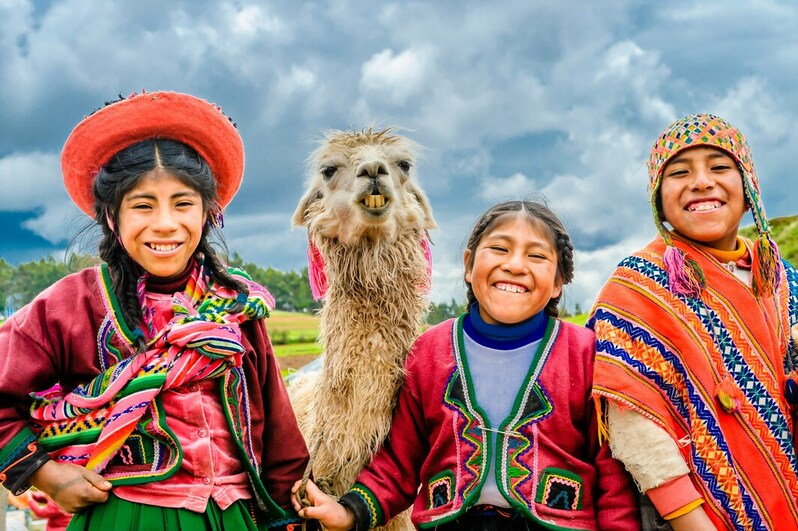
50 Essential Peruvian Spanish Expressions (and How Peruvians Really Use Them)
Share
Introduction
You think you know Spanish - until you land in Lima and someone hits you with “¡Qué palta!” or “Jameamos al toque, causa.”
Peruvian Spanish is a different beast. It’s fast, expressive, sometimes brutal, and always clever. You won’t find this stuff in grammar books - but it’s exactly what people use on the street, in markets, on TikTok, and at the bar with their patas.
In this post, you’ll get 50 expressions that Peruvians actually use - from the coast to the mountains to the jungle. Each one comes with meaning and context, so you can not only understand them but also use them without sounding like a robot.
Whether you're visiting Peru, chatting with locals online, or just obsessed with Latin American slang, this is your no-fluff guide to speaking like you belong. Let’s get into it.

Why Learn Peruvian Spanish?
Because it's not just Spanish - it's Peruvian Spanish. And that means it's packed with flavor, rhythm, and attitude you won't hear anywhere else.
Peruvians speak fast, cut words short, mix in Quechua, invent phrases on the fly, and somehow make it all sound effortless. The accent is clear enough for learners, but the slang hits different. You’ll hear “al toque,” “pata,” “chamba,” and “jato” before you even get to the plaza.
Learning Peruvian Spanish means understanding how people actually speak in Lima, Cusco, Trujillo, Arequipa and beyond. It means being part of the rhythm of the streets - not stuck in textbook mode. Whether you're ordering anticuchos at a street cart or watching memes on Instagram, knowing the local expressions turns everything on.
If you're serious about speaking Spanish like a real human - Peru is where you level up.

Top 50 Peruvian Spanish Expressions
These aren’t academic terms - they’re words and phrases you’ll actually hear on the streets of Lima, in WhatsApp chats, and blasting from a colectivo. Learn them, recognize them, and when the time is right - drop them naturally.
Greetings and Everyday Talk
- ¿Qué fue? - What’s up? A common way to say hi.
- ¿Qué tal, causa? - How’s it going, bro? “Causa” is a close friend.
- Al toque - Right away. Immediately. Super common.
- Habla - Literally “speak” - used to say “tell me” or “what’s up?”
- Ya pe - Equivalent to “come on” or “ok then.” Adds emphasis or pressure.
Street Slang and Humor
- Pata - Friend, dude, buddy. Very casual.
- Jato - House or home. “Vamos a mi jato.”
- Palta - Embarrassment. “Qué palta” = how embarrassing.
- Jamear - To eat. Comes from “jama” = food.
- Roche - A shameful or awkward situation. “Qué roche.”
Work, Money and Survival
- Chamba - Work or job. “Estoy buscando chamba.”
- Chambear - To work. Verb form of “chamba.”
- Estar misio - To be broke. No money at all.
- Plata - Money. “No tengo plata.”
- Pituco - Rich or posh person. Not always flattering.
Food and Drink
- Chela - Beer. “Vamos por unas chelas.”
- Anticucho - Beef heart skewers - and also used jokingly in slang.
- Picar - To snack or share food. “Vamos a picar algo.”
- Calato - Naked. Also used for very revealing clothes.
- Trago - Alcohol or drinks. “Hay trago en la jato.”
Emotions and Reactions
- Asado - Annoyed or pissed off. “Estoy asado.”
- Mate de risa - Hilarious. “Ese video me mató de risa.”
- Chévere - Cool or great. Universal in Latin America but common in Peru too.
- Piña - Unlucky person. “Qué piña ese pata.”
- Misio - Another way to say broke. Often used between friends.
Culture and Regional References
- Cholo - Used informally to refer to someone, often affectionately. Context is everything.
- Serrano - Someone from the highlands. Can be neutral or offensive depending on tone.
- Charapa - Person from the Amazon region. Also the name of a turtle.
- Costeño - Person from the coast.
- Grone - Afro-Peruvian slang term. Be cautious - it's very context-sensitive.
Expressions About Life
- Estar hasta las patas - To be in a mess or do something badly.
- Estar en nada - To be doing nothing important or productive.
- Hacerla larga - To drag something out unnecessarily.
- Hacerse bolas - To get confused. “Me hice bolas con esa explicación.”
- Pasar piola - To go unnoticed. “Pasé piola en el examen.”
Common Reactions and Filler Words
- Oe - Equivalent to “hey” or “yo.” Used to call attention.
- Ya fue - It’s over. Let it go. Move on.
- Ni cagando - No way. Absolutely not. Strong, informal.
- Qué bestia - Wow, unbelievable (positive or negative).
- Fácil - Maybe or probably. “Fácil llega tarde.”
Internet, Youth and Modern Use
- Modo avión - To go offline or ignore everyone. Borrowed from phone settings.
- Tóxico - Toxic (used jokingly about relationships or people).
- Estar fresh - To be chill. Calm, relaxed, not worried.
- Buena onda - Someone nice, cool, good vibes.
- Quedarse jato - To fall asleep. “Me quedé jato viendo Netflix.”
Final Stretch
- Chibolo - Kid or young person.
- Viejo - Dad. Used casually, not disrespectfully.
- Tío - Guy, man, dude. Not just your literal uncle.
- Broder - Peruvianized “brother.” Used like “bro.”
- Ya fue todo - It’s all over. Nothing left to do. Let’s move on.
Now you’ve got 50 expressions that open up real Peruvian Spanish - not the version in your language app. Use them, listen for them, and enjoy sounding like you actually get it.
Real-Life Examples: Expressions in Context
You’ve seen the list. Now here’s how Peruvians actually use these expressions in real conversations, music, and everyday life. No made-up textbook stuff - just real talk.
🗣️ Everyday Conversations
Two friends after class:
— Oe, ¿vas a la jato de Lucho hoy?
— Al toque, causa. Pero estoy misio, ¿hay trago?
(Hey, going to Lucho’s place today? - Right away, bro. But I’m broke, is there any booze?)
In a market in Lima:
— ¿Me das medio kilo de tomate?
— Ya pe, causa, pero está un poco caro hoy.
(Can I get half a kilo of tomatoes? - Sure, bro, but it’s a bit pricey today.)
📺 TV and YouTube
From a sketch by El Wasap de JB:
“Ese pata siempre se hace el loco para no chambear.”
(That guy always acts clueless to avoid working.)
From a viral clip on TikTok Perú:
“Fácil me lanzo con ella - total, ya fue todo.”
(Maybe I’ll go for it with her - whatever, it’s all over anyway.)
🎵 Peruvian Music Lyrics
Song: “Lejos de ti” – Grupo 5
“Siento que me muero, que sin ti me mata el corazón.”
Classic cumbia heartbreak - and perfect for a dramatic “tengo una tusa” moment.
Urban slang in freestyle battles:
“Estoy fresh, ni cagando me ganan.”
(I’m chill - there’s no way they beat me.)
These expressions aren’t hidden in books - they’re alive in the music, shows, jokes and daily rhythm of Peruvian life. The more you expose yourself to the real thing, the faster you’ll own it.

Peruvian Spanish in Media and Pop Culture
If you want to pick up Peruvian slang naturally, you need to dive into what Peruvians actually watch and listen to. That’s where the real language lives - fast, funny, and full of flavor.
📺 TV and Comedy
- El Wasap de JB – Legendary sketch comedy show full of slang, accents and stereotypes from all over Peru.
- Pataclaun – Classic absurd humor that helped shape modern Peruvian pop culture and slang.
- Esto es Guerra – Reality TV that uses tons of everyday expressions, especially from young people.
🎵 Music
- Grupo 5, Armonía 10, Corazón Serrano – Cumbia hits full of street-level romantic slang and emotional expressions.
- Gian Marco, Pedro Suárez-Vértiz – More poetic but still rooted in Peruvian rhythm and phrasing.
- Rap y freestyle peruano – Artists like Jaze, Stick and Nekroos use modern Peruvian slang in battles and lyrics.
📱 TikTok and YouTube
- @quevedo.jr – Peruvian content creator who jokes about Lima slang and cultural quirks.
- Josi Martínez – TikToker using current slang in comedy and reaction videos.
- Hashtags to explore: #JergaPeruana, #PeruvianSpanish, #SlangPeru
The best way to make Peruvian Spanish part of your life is to immerse yourself in the content locals enjoy. Watch, listen and repeat until it clicks - and then, suddenly, it’s yours.
Conclusion
Peruvian Spanish is more than just words - it’s a living, breathing expression of culture, humor and attitude. From “pata” to “al toque” to “qué palta,” these phrases are the key to sounding like someone who gets it, not someone stuck in a classroom.
You’ve seen 50 real expressions. You’ve heard them in music, shows and everyday talk. Now they’re yours. Use them, spot them, and most of all - enjoy them.
The more you dive into Peruvian Spanish, the more connected you’ll feel to the people and the culture. And trust us - that connection is worth it.
This is how you stop translating and start speaking like you belong.

